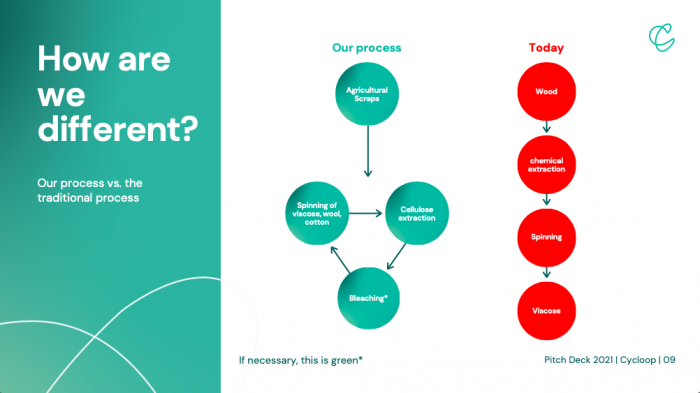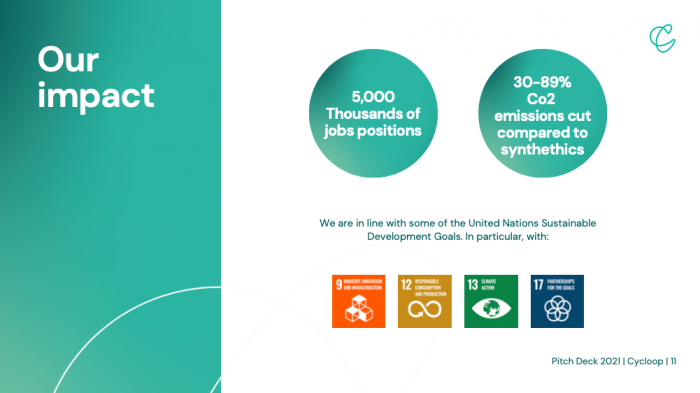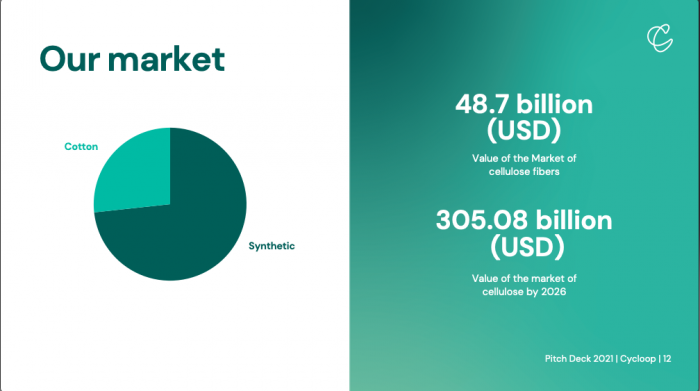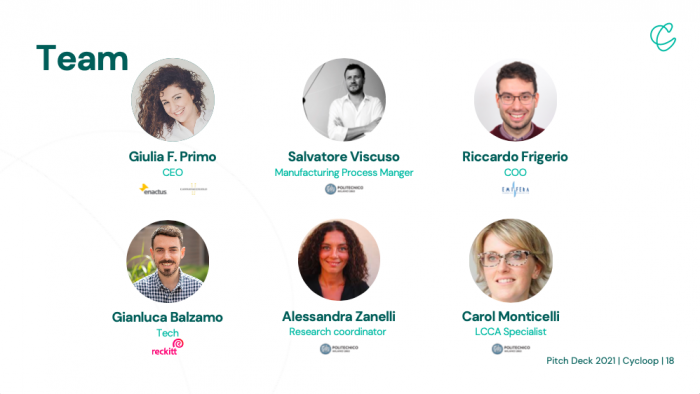I. SUMMARY INFORMATION
Project
269659
Status
Submitted
Award category
Techniques, materials and processes for construction and design
You want to submit
NEW EUROPEAN BAUHAUS AWARDS : existing completed examples
Project title
Cycloop
Full project title
Cycloop | Know how that makes the building sector greener and high-quality.
Description
Design and building construction sectors failed to take an integrated approach towards quality, price, and sustainability. This is due to a lack of collaboration and cooperation within and outside supply chains that leads to the go-to-market of (new) products. Cycloop fills the gap in the know-how of manufacturers, fostering collaboration among actors in the supply chains of design, building construction, and textile making them better off and positively impacting people and the environment.
Where was your project implemented in the EU?
Italy
Lombardy
Via Aosta 14
45.46342
9.19405
Milan
20155
When was your project implemented?
Has your project benefited from EU programmes or funds?
No
Which programme(s) or fund(s)? Provide the name of the programme(s)/fund(s), the strand/action line as relevant and the year.
II. DESCRIPTION OF THE PROJECT
Please provide a summary of your project
Cycloop aims to revolutionize the world of biopolymers. We research new biopolymers - in collaboration with big research hubs in Europe (such as ENEA, POLIMI and UNIGE), and develop knowledge to make fashion manufacturers greener, more ethical, and better-performing. We are currently working on a solution for extracting and working on cellulose from agricultural scraps and raw materials coming from inefficient crops, so to replace cellulose produced from trees and at the same time use cellulose and textile in the design and building sector in new and innovative ways.
In a perfect world scenario, people and enterprises would choose to buy and produce high quality and natural design products only. Unfortunately, price is a constraint and makes designers, manufacturers, and customers unable or unwilling to buy design produced with natural fibers/ materials. For this reason, synthetic and artificial fibers entered the market, and represent 63% of textiles consumed every year. These fibers do not perform as good as natural materials, and present several limitations, above all when it comes to insulation or textile usage for building and design - temperature regulation, handling, and look and feel are just part of the issue. Textile manufacturers cannot provide, at the moment, efficient and cost-effective solutions to this problem. At Cycloop, we identified bumper crops that have the lowest cost for the production of a green cellulose and fibers. As an ancillary benefit, the textile technology will help save 5,000 job positions and respect the environment.
Please give information about the key objectives of your project in terms of sustainability and how these have been met
inThe so-called clean-tech solutions - that tackle the issue of sustainability and ethics - have often failed to consider the importance of either: (1) price; (2) characteristics in terms of product performance that are salient for customers; (3) reason holistically about their impact on the environment and people, relying on sustainable development just as means to appeal to new consumers (greenwashing).
In this respect:
People - want high-quality products at an affordable price; but not just that: they are increasingly sensitive and conscious about green and ethical issues when they purchase products;
Universities: want to collaborate with the industry, but somehow lack knowledge and ability to work alongside the industry in a meaningful way, so to promote a go-to-market of new products that is meaningful for markets;
Workers: with the Covid-19 global pandemic, several jobs have been lost.
Agricultural sector: raw materials, work conditions; Cycloop fills the gap that exists between universities, the industry and their supply chain, and people. Universities do develop innovative solutions, but they hardly get to the industry because of problems with infrastructure. We enter this gap, making sure to bridge the needs of industry while respecting innovation brought by scholars
What we impact:
Sustainable Development (the UN’s SDGs), and especially goal number 8 (decent growth and economic growth), by promoting a green and circular economic model that allows farmers to increase their margins and, therefore, make more profits and regulate jobs better;
Sustainable Development Goals number 13, climate action. By starting from sources that are different from wood, we save thousands of trees, In addition, we remove water, oil and chemicals from our process, cutting emission from 70% to 89% compared to syntethic/ non-sustainable alternatives.
Please give information about the key objectives of your project in terms of aesthetics and quality of experience beyond functionality and how these have been met
We are R&D a technology to produce and process green cellulose that can be applied to the building and design sector in different ways, in its raw form or spinned (in a green method) and therefore resulting in a textile.
When cellulose:
* it can be used in insulation increasing performance of current insulating systems; Cellulose has proven better in terms of temperature regulation, handling, and maintainance. In this way end-users can save money and live more green;
When a textile:
* we improve the pricing, keeping the premium very low and lowering it so to match non-sustainable alternative price;
* we improve look and feel of current sustainable and synthetic options for textiles;
Benefits for manufacturers that buy the technology:
* Diversify the production;
* increase margin;
* being able to start from different and local raw materials so as to preserve the biodiversity of the country.
Please give information about the key objectives of your project in terms of inclusion and how these have been met
We are currently developing the technology, and registering our first patent soon.
Our main objective are related to business and sustainable impact, and are the following:
Give a second chance to waste and people
Due to the Covid-19 pandemic and problems in innovation of the agricultural sector, agriculture has tons of social issues to face. Among those:
Precariousness of work in the sector;
Black labour
Agricultural scraps are not valued as they should, and a substantial need for new biobased polymers exists (Resource).
Solve the tension between quality, price, and sustainability
Selling sustainable products just for the sake of sustainability is an issue.
CleanTech, while subject to different trends recently, has much more issues when it comes to receiving funding and growing.
Resources
The reason why CleanTech fails is due to the inability of founders to address critical problems for the market and for the environment.
Resources
In other words, they either:
discount too much the performance of the product and just focus on its sustainability;
or they discount too much the pricing;
or they address an issue (e.g. plastic & its NECESSARY USE) which is truly not relevant for markets;
or all of the above together;
Avoid investing in direct productions
improve the existing production plants;
Allow them to be better off and create work position;
Bond them to be more sustainable;
Please give information on the results/impacts achieved by your project in relation to the category you apply for
We were able to complete the research for cellulose extraction (currently applying to the first patent) and separate the different components of agricultural scraps in a green way, so to use cellulose for different applications.
Please explain the way citizens benefiting from or affected by the project and civil society have been involved in the project and what has been the impact of this involvement on the project
If 1% of the market of cellulose was to adapt our technology, the planet would cut down CO2 emissions by 2% globally.
We are able to recreate supply chain in the whole world based on local needs.
Please highlight the innovative character of the project
We are inventing new products from agricultural scraps, and we have invented from scratch - or almost - a technology that allow us to do so.
Please explain how the project led to results or learnings which could be transferred to other interested parties
Being this an innovation for the industry, in collaboration with research hubs in Europe, the technology can be used by any manufacturer in the world and we can build localized supply chain everywhere in the world.
Is an evaluation report or any relevant independent evaluation source available?
No
III. UPLOAD PICTURES
IV. VALIDATION
By ticking this box, you declare that all the information provided in this form is factually correct, that the proposed project has not been proposed for the Awards more than once under the same category and that it has not been subject to any type of investigation, which could lead to a financial correction because of irregularities or fraud.
Yes





